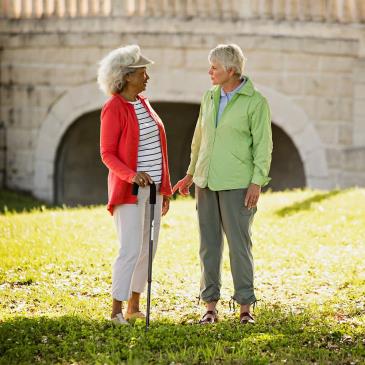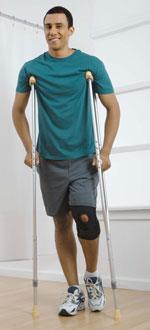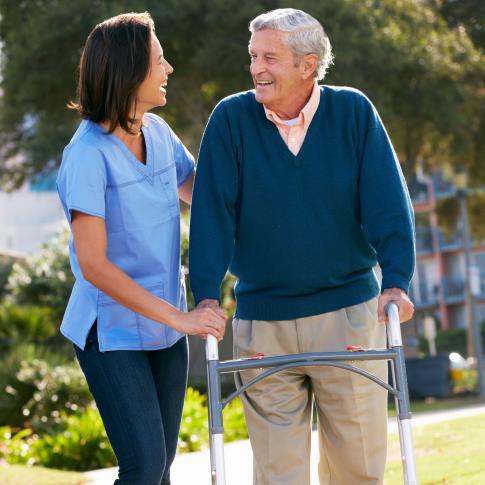Simple Devices Can Make a Big Difference
August 31, 2016
When it comes to choosing an assistive device, such as a cane or crutches, there are several options. Some provide stability, but are quite bulky. Others are less cumbersome, but provide less support.
 A cane can have a single point or four points (a quad cane). The quad cane provides additional stability, but added weight comes with that extra stability. In order to properly adjust the cane, stand up nice and tall, with your arm straight at your side. The top of the cane handle should come to the bed in your wrist. The cane should be placed in the hand opposite of the affected extremity. For example, if your right knee is injured, the cane would be held in the left hand. This reduces the amount of force through the injured extremity. When walking, the cane and the affected extremity move at the same time. So, take a step with the injured extremity, moving the cane forward, in the opposite hand, at the same time. Then, step through with the good, uninjured leg.
A cane can have a single point or four points (a quad cane). The quad cane provides additional stability, but added weight comes with that extra stability. In order to properly adjust the cane, stand up nice and tall, with your arm straight at your side. The top of the cane handle should come to the bed in your wrist. The cane should be placed in the hand opposite of the affected extremity. For example, if your right knee is injured, the cane would be held in the left hand. This reduces the amount of force through the injured extremity. When walking, the cane and the affected extremity move at the same time. So, take a step with the injured extremity, moving the cane forward, in the opposite hand, at the same time. Then, step through with the good, uninjured leg.
 Crutches can provide a little more stability than a cane, as there are two points of contact with the ground. When adjusting crutches, again stand nice and tall, with your arm straight at your side. The crutches should be positioned so they are about 6 inches out from the sides of your feet. The hand grip should hit right at the bend in your wrist, when the arm is straight. You should be able to place 2 fingers between the top of the crutch and your armpit. Crutches are meant to be used by squeezing them a bit to your side and bearing weight through your arms, not leaning on the crutches at your armpits. Just as in walking with the cane, the crutches move forward with injured leg. Then, step through with good leg.
Crutches can provide a little more stability than a cane, as there are two points of contact with the ground. When adjusting crutches, again stand nice and tall, with your arm straight at your side. The crutches should be positioned so they are about 6 inches out from the sides of your feet. The hand grip should hit right at the bend in your wrist, when the arm is straight. You should be able to place 2 fingers between the top of the crutch and your armpit. Crutches are meant to be used by squeezing them a bit to your side and bearing weight through your arms, not leaning on the crutches at your armpits. Just as in walking with the cane, the crutches move forward with injured leg. Then, step through with good leg.
 Walkers provide the most stability, but are a bit more cumbersome. They can come with or without wheels. Many have expressed concern that the wheeled walker may "get away from them." If you're are bearing weight through the walker and using it properly, this should not happen. Standing tall, with the arms straight at your side, the top of the walker handle should come to the bend in your wrist. With walking, push the walker forward first, stepping on the injured leg, and then bringing the good leg forward.
Walkers provide the most stability, but are a bit more cumbersome. They can come with or without wheels. Many have expressed concern that the wheeled walker may "get away from them." If you're are bearing weight through the walker and using it properly, this should not happen. Standing tall, with the arms straight at your side, the top of the walker handle should come to the bend in your wrist. With walking, push the walker forward first, stepping on the injured leg, and then bringing the good leg forward.
With stairs, a handrail, if present, is the best, most stable option to assist in this task. If there is no handrail or only one, the chosen assistive device generally stays with the affected leg. Going up stairs, you lead with your strongest leg, then follow with the affected leg and assistive device. Going down stairs, you lead with the weakest or injured leg. So, the injured leg and assistive device go first, followed by the strongest leg.
If you have any specific questions about what device would be most appropriate for you or how to use any assistive devices, please don't hesitate to ask.